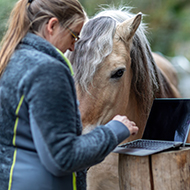Researchers looked at French bulldogs and spaniel breeds.
A new study by researchers at the University of Edinburgh has suggested that the high prevalence of humeral intracondylar fissures in French bulldogs may predispose the breed to developing humeral condylar fractures.
The research team looked for common factors in cases of front leg breaks in French bulldogs, a breed known to be susceptible to elbow breaks as they grow.
To do this, the researchers compared the anatomy of the broken limbs with the other unbroken front leg in dogs treated at the Dick Vet’s Hospital for Small Animals.
They also compared CT scans from the French bulldogs with scans from spaniel breeds, which are also known to be susceptible to elbow fractures, to try to understand if the breaks had a similar cause.
French bulldogs are at above average risk of elbow fractures when young, the study found. In comparison, spaniels are more likely to develop the injury when adults.
However, despite this difference, naturally occurring hairline cracks were common in the elbow joints of both breeds. This suggests, according to the researchers, that intracondylar fissures may be a contributing predisposing factor, although the variation in risk as each breed ages most probably means that the cause of injury is different between them.
Sclerosis in the affected bone was also common in both breeds.
Sumari Dancer, a lecturer in diagnostic imaging and co-author of the study, said: “This type of fracture is prevalent in both breeds, and the injuries look the same, but their development is different – so perhaps the biological mechanism varies.
“Our findings reinforce previous reports that French bulldog puppies are predisposed to these types of elbow breaks, which are known to be common in spaniels.
“Vets and owners should be aware and discuss how best to mitigate the risk in French bulldog puppies.”
Professor Dylan Clements, chair of small animal orthopaedics at the University of Edinburgh and co-author of the study, added: “Humeral intracondylar fissures predispose dogs to catastrophic fractures of the elbow which can be difficult and expensive to treat, often requiring referral to a specialist surgeon. This is particularly true in the French bulldog breed, due to their size and conformation.”
The study has been published in the journal Veterinary Radiology and Ultrasound.
Image (C) Shutterstock



 With Strangles Awareness Week just around the corner (5-11 May), vets are being encouraged to share a survey about the disease with their horse-owning clients.
With Strangles Awareness Week just around the corner (5-11 May), vets are being encouraged to share a survey about the disease with their horse-owning clients.